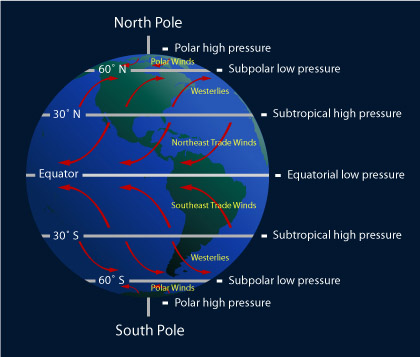|
Solar EnergyYou learned in lesson 3 that some areas of the earth get more solar energy, or heat, than other areas. Because warm air is less dense, the areas with warm air are low-pressure areas. Since cool air is dense, the areas with cold air are high-pressure areas. The variations in temperature cause air to develop currents and cycle around the earth. There are multiple high and low pressure areas on the earth, and the cycling process is quite complicated, but the following will give you a basic idea of how it works. The equatorial regions receive more of the sun's heat than other areas of the earth; the solar energy heats the air, which creates a low pressure region along the equator. As the sun heats the atmosphere, the air rises. When the air reaches the upper atmosphere, it cools off and flows toward the poles. There the air becomes very cold and dense, and this causes it to sink back to the surface of the earth. The cold, dense air flows along the surface of the earth, eventually reaching the warmer areas of the earth where it is warmed by the sun. As the sun heats it, the air becomes less dense and begins to rise and the cycle continues.
Horizontally flowing air is called wind. Wind always flows from high pressure regions to low pressure regions. Think of an empty balloon; in normal circumstances air will not flow into the balloon. The only way to get air into a balloon is to use high pressure. If you make a small hole in a filled balloon, the air will rush out of the balloon; this is because the filled balloon is a higher air pressure environment than the outside air. Some areas have winds that blow from the same direction most of the time. These are called prevailing winds. In the northern US, the prevailing winds are called westerlies because the wind flows generally from the west towards the east. The prevailing winds significantly impacted early shipping routes because the ships relied on wind power to move across the oceans. Look at Figure 4.1.2. Notice how the direction of the wind alternates with the pattern of high and low pressure systems. Along the equator there is usually low atmospheric pressure and very little wind. Sailors named the area the “doldrums.” This was because sailing vessels in the past depended almost exclusively on the wind for power, and since there are no prevailing winds in this area, ships could be stuck in the area for long periods of time. The phrase “to be stuck in the doldrums” now means “to feel sad or bored”. Figure 4.1.2 shows the general pattern for high and low pressure systems as well as the prevailing winds for each area. Notice the pattern of low and high pressure systems. Remember that near the equator the air is warm, which means it is less dense than cool air. The equatorial low pressure systems are bordered by subtropical high pressure systems, composed of cooler air. The high pressure systems push the cooler air towards the equator, producing the trade winds. Can you guess why they are called trade winds? Like the doldrums, the trade winds were named by sailors. The trade winds provided the wind power that trading ships needed to sail across the ocean. If you were sailing from Africa and you wanted to get to South America, you would probably rely on the southeast trade winds to power the ship.  
|
About Us | Terms of Use | Contact Us | Partner with Us | Press Release | Sitemap | Disclaimer | Privacy Policy
©1999-2011 OpenLearningWorld . com - All Rights Reserved


